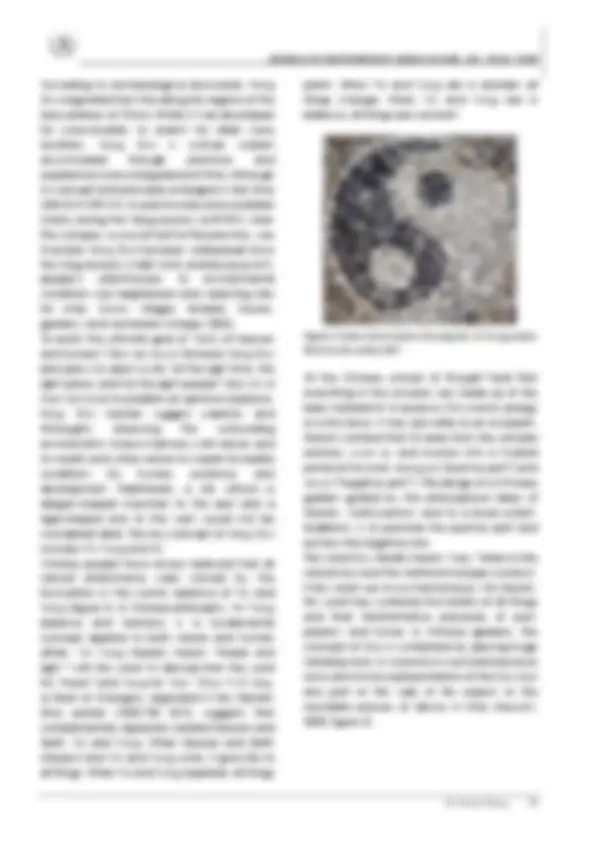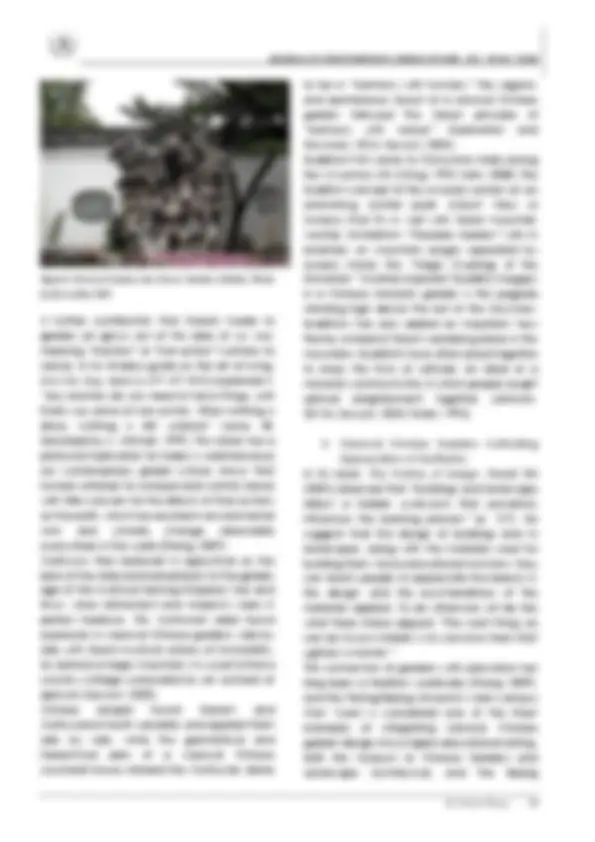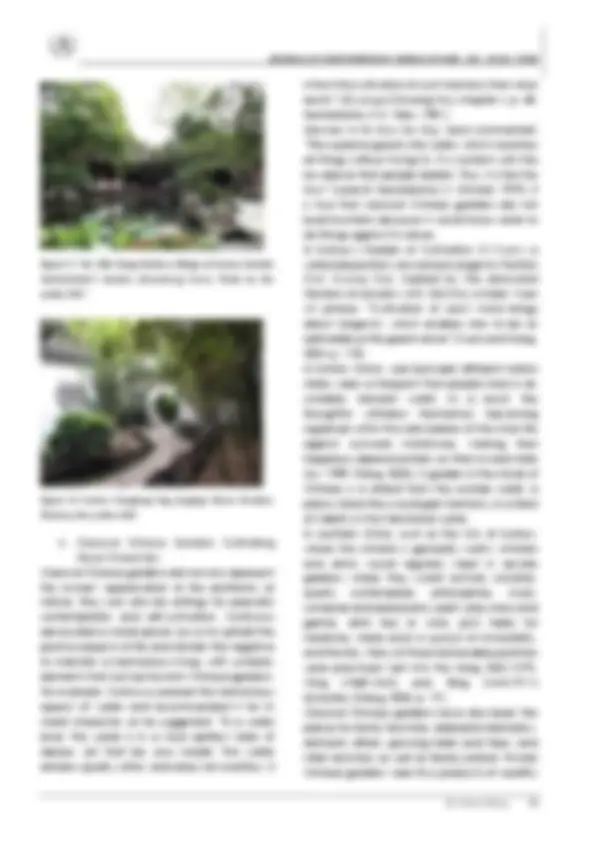








Study with the several resources on Docsity

Earn points by helping other students or get them with a premium plan


Prepare for your exams
Study with the several resources on Docsity

Earn points to download
Earn points by helping other students or get them with a premium plan
Community
Ask the community for help and clear up your study doubts
Discover the best universities in your country according to Docsity users
Free resources
Download our free guides on studying techniques, anxiety management strategies, and thesis advice from Docsity tutors
Classical Chinese Gardens: Landscapes for Self-Cultivation
Typology: Essays (university)
1 / 12

This page cannot be seen from the preview
Don't miss anything!







2018 , Volume 2 , Number 1 , pages 33 – 44
Oxford Brookes University, UK E mail: donia.zhang@oxfordbrookes.net
https://doi.org/10.25034/ijcua.2018. www.ijcua.com Copyright © 201 8 Contemporary Urban Affairs. All rights reserved.
1. Introduction A garden is a form of art that is related to nature as well as culture. One aspect of their perpetual appeal to people is that in a garden, art and science, mind and nature, finally intersect. Many world philosophies or religions regard the planet earth as a garden. Christians believe that the “Garden of Eden” once existed in Mesopotamia of the Near East, and the “Hanging Garden” of Babylon has ever captivated humans’ creative imagination. Chinese people then believe that “There is Heaven above, there is Su-Hang below” (Su represents “Suzhou,” and Hang for “Hangzhou,” two historic Chinese cities with classical gardens). These sayings demonstrate humans’ cosmological awareness of the interconnection between gardens and the universe from an earlier time.
Article history: Received 30 July 2017 Accepted 07 Augusts 2017 Available online 08 Augusts 2017 Keywords: Chinese landscape architecture; Chinese garden; Chinese philosophy; Ethics; Aesthetics; Morality. This work is licensed under a Creative Commons Attribution - NonCommercial - NoDerivs 4.0. "CC-BY-NC-ND"
Historically in China, mountains were viewed as connections between heaven and earth, and water as a reflection of the vast emptiness of the universe. As such, mountains and water are two fundamental elements in Chinese landscape architecture, as Confucius (551- 479 BCE) contended: “The wise find pleasure in water; the virtuous find pleasure in hills.”^1 Living close to mountains and water was Chinese people’s ideal since antiquity. However, a hermit lifestyle might not suit everyone. Thus, they created gardens with rocks and water within the confines of their private homes to be close to nature. Based on their functions, Chinese gardens fall into three categories: imperial, monastic, and residential. This paper focuses on Suzhou’s residential gardens because, of all Chinese cities, Suzhou has the largest number of private gardens, the most beautiful in style (figure 1), and the highest in artistic and construction quality (Keswick, 2003; Shao, 2005; Yuan and Gong, 2004). A Suzhou garden had always been an integral part of a house, and the Chinese concept of a home is explicitly expressed in the terms yuanzhai , meaning “courtyard/garden-house,” or jiating , denoting “home-courtyard/garden” (Wang, 2005; Yu, 2007). Suzhou had about 270 private gardens of various sizes in the Ming dynasty (1368-1644), over 60 are preserved, 19 open to the public today, and nine are on UNESCO’s World Heritage List. 2 (^1) Confucian Analects , Book 6 Chapter 21; translated by J. Legge, 1893/1971, p. 192. (^2) UNESCO’s Suzhou gardens list: Zhuozheng Yuan (The Humble Administrator’s Garden), Liu Yuan (The Lingering Garden), Wangshi Yuan (The Master-of-Nets Garden), Huanxiu Shanzhuang (Mountain Villa with Embracing Beauty), Canglang Ting (Surging Waves Pavilion), Figure 1. Suzhou Lingering Garden ( Liu Yuan ). Photo by the author 2007
2. Classical Chinese Gardens Cultivating Environmental Ethics In his essay “The Philosophy of Wilderness,” Shane Steinkamp argued that “To protect the nature that is all around us, we must think long and hard about the nature we carry inside our heads” (n.d.). He means that humans must uphold a correct attitude towards nature in order to protect the natural environment, which would require a cultivation of our minds. A Chinese garden is a cosmic diagram revealing a profound view of the world; it is nature in a nutshell that enables one to feel the charm of nature, such as mountains, forest, and springs, without going out of the bustling city. When designing a Chinese garden, Feng Shui had often been applied. Feng Shui , literally means “wind and water,” is Chinese cosmology for determining whether the potential site would bring health, wealth, or misfortune to the occupants. Dating back some 5,000 years ago, Feng Shui can be found in classics such as Shijing (Book of Odes), Shujing (Book of History), Huangdi Zhai Jing (Yellow Emperor’s Canon on Houses), and other fragmentary texts in the Western Zhou period (1066-771 BCE). Shizilin (The Lion Grove Garden), Yipu (The Garden of Cultivation), Ou Yuan (The Couple’s Garden of Retreat), and Tuisi Yuan (The Retreat and Reflection Garden) (Exploration and Discovery, 2016; Shao, 2005; Yu, 2007; Yuan and Gong, 2004). Suzhou is nicknamed the “Back Garden” of Shanghai as it is only 83 km to the northwest of it, about 30 minutes by high-speed train.
Figure 3. Rocks at Suzhou Lion Grove Garden ( Shizilin ). Photo by the author 2007 A further contribution that Daoists made to garden art grows out of this idea of wu wei, meaning “inaction” or “non-action” contrary to nature. In his timeless guide on the art of living, Dao De Jing , Laozi (c.571-471 BCE) explained it: “Less and less do you need to force things, until finally you arrive at non-action. When nothing is done, nothing is left undone” (verse 48, translated by S. Mitchell, 1999). This notion has a profound implication for today’s world because our contemporary global culture shows that humans attempt to conquer and control nature with little concern for the effects of their actions on the earth, which has resulted in environmental crisis and climate change observable everywhere in the world (Zhang, 2009). Confucius then believed in agriculture as the basis of the state and looked back to the golden age of the mythical farming Emperors Yao and Shun, when refinement and simplicity were in perfect balance. This Confucian ideal found expression in classical Chinese gardens, side by side with Daoist mystical notions of immortality. So, behind a magic mountain, it is usual to find a country cottage surrounded by an orchard of apricots (Keswick, 2003). Chinese people found Daoism and Confucianism both valuable, and applied them side by side: while the geometrical and hierarchical plan of a classical Chinese courtyard house mirrored the Confucian desire to be in “harmony with humans,” the organic and spontaneous layout of a classical Chinese garden followed the Daoist principle of “harmony with nature” (Exploration and Discovery, 2016; Keswick, 2003). Buddhism first came to China from India during the 1st century AD (Ching, 1993; Kohn, 2008). The Buddhist concept of the universe centers on an astonishing central peak (Mount Meru or Sumeru) that fits in well with Daoist mountain worship. Amitabha’s “Paradise Garden” with its emphasis on mountain ranges separated by oceans mirrors the “Magic Dwellings of the Immortals.” Another important Buddhist imagery in a Chinese monastic garden is the pagoda standing high above the rest of the structures. Buddhism has also added an important new theme: instead of Daoist wandering alone in the mountains, Buddhists have often joined together to enjoy the fruits of solitude, an ideal of a monastic community life, in which people sought spiritual enlightenment together (Johnson, 2017a; Keswick, 2003; Porter, 1993).
3. Classical Chinese Gardens Cultivating Appreciation of Aesthetics In his book, The Nature of Design , David Orr (2002) observed that “buildings and landscape reflect a hidden curriculum that powerfully influences the learning process” (p. 127). He suggests that the design of buildings and its landscapes, along with the materials used for building them, have educational functions: they can teach people to appreciate the beauty in the design, and the eco-friendliness of the materials applied. To do otherwise will be like what Rene Dubos argued: “The worst thing we can do to our children is to convince them that ugliness is normal.” The connection of gardens with education has long been a tradition worldwide (Zhang, 2009), and the Peking/Beijing University's main campus (Yan Yuan) is considered one of the finest examples of integrating classical Chinese garden design into a higher educational setting. Both the Museum of Chinese Gardens and Landscape Architecture, and the Beijing
Planning Exhibition Hall, have displayed the campus' original plans. Classical Chinese residential gardens have also tried to incorporate a little of every experience on an aesthetic level. The Qing-dynasty writer, Shen Fu (1763-1825?), put it explicitly: “The aim is to see the small in the large, to see the large in the small, to see the real in the illusory, and to see the illusory in the real” (Keswick, 2003, p. 213; Shao, 2005, p. 5; Yu, 2007, p. 245). Classical Chinese garden designs have always integrated the aesthetic theory of xu shi , which can be interpreted in numerous ways. Xu may denote “void, virtual, potential, unreal, intangible, formless, or deficient,” while shi may signify “solid, actual, real, tangible, formed, or full” (Zhang, 2013/2016, p. 54). The application of xu shi to Chinese garden design is revealed in an unlimited series of opposite qualities played off against each other: a dark narrow corridor between two high walls followed by a wide space full of sunlight, void in solids, solids in a void, small leads to big, low to high, and the like (Keswick, 2003; Shao, 2005; Wang, 2005; Yu, 2007). Due to its warm southern climate and favorable natural conditions for growing lush green woods, Suzhou is a place where “one can enjoy landscapes without going outside the city, and live in busy streets with the sights of forests and tastes of spring water” (my translation). Suzhou thus was praised as a “City of Gardens” and “Paradise on Earth.” In imperial China, retired officials, literati, and wealthy merchants would like to settle in Suzhou, resulting in its prolific number of outstanding talents and renowned celebrities (Zhang, 2013/2016). Ming-dynasty garden designer, Ji Cheng (1582- c.1642), who was a Suzhou native, wrote Yuan Ye ( The Craft of Gardens , 1631), which is the first monograph dedicated to landscape architecture, and which has been translated into many different languages (Hardie, 1988/2012). A famous passage from it reads: “Although the (^3) See, for example, Exploration and Discovery, 2016; Shao, 2005, p. 5; Yu, 2007, p. 265; Yuan and Gong, 2004, p. 116. gardens are created by the human hand, they should appear as if the work of nature.”^3 Another celebrated volume on Chinese landscape architecture is the 12-chapter Zhang Wu Zhi ( Treatise on Superfluous Things , 1621) by Wen Zhenheng (1585-1645), who was also a Suzhou native and a Ming-dynasty scholar, painter, garden designer, and great grandson of Wen Zhengming (1470-1559, a famous Ming- dynasty painter). While Yuan Ye focuses on gardening techniques and plants in southern China, Zhang Wu Zhi concentrates on the enjoyment of garden views and plants in northern China. Chinese garden designers intended to recreate the effect of totality of nature in a generally small space of a private garden to represent nature’s infinite change and mystery, and to provide seclusion. There were no planning guidelines for Chinese gardens: organic, spontaneous, and asymmetrical were the main characteristics. In its overall layout, the garden designers paid special attention to the terrain, sight, and views. The Chinese word for landscape is shan shui , which literally means “mountains and water,” because Chinese people have observed that where there are mountains, there is bound to be water in the same place. As such, rocks and water constitute the most basic Chinese garden elements, followed by trees, flowers and herbs, walls, gates and windows, pavilions and pagodas, winding corridors, zigzag bridges, footpaths, and so on. Each element has its metaphor, with layers of meanings. Rocks come from mountains, and mountains symbolize eternity. Chinese people love rocks by placing them in their gardens to gain immortality. Opening on all sides, rocks allow the viewers to see things behind, thus suggesting insight and wisdom (figure 3). The heart of a Chinese garden is water (figure 4); along with rocks they form a unity between dynamic and static, and horizontal and vertical
Figure 7. Gourd-shaped Gate at Suzhou Calm Garden ( Ding Yuan ), behind which is the Tea House. Photo by the author 2007 The pavilion is the focal point of a classical Chinese garden and a delightful resting place where visitors can sit for a quiet talk or contemplation (figures 4 and 8). The roofed and open-sided gallery corridors wind up and down the site, connecting pavilions and gateways, at the same time dividing up the space like a screen (figure 9). They unite the garden as a whole and serve as a frame for viewing the garden and as a sheltered walkway. Walking through the corridors is like being inside and outside at the same time (figures 9, 10, and 11). Ancient Chinese people believed that all evil spirit travels in straight lines. To prevent this, they built garden bridges in zigzag shapes (figure 8). The paths made of stone, brick, or pebble mosaic would have a variety of patterns and themes to harmonize the different occasions on a garden walk (figures 2 and 12). Libraries and study rooms were an integral part of nearly all classical Chinese gardens. Their owners’ time was often spent practicing calligraphy and writing poetry, often in the company of family or friends. Such rooms were usually secluded and surrounded by private courtyard gardens to protect the readers and give them a pleasant view to look out. Figure 8. Pavilion and zigzag bridge at Suzhou Humble Administrator’s Garden ( Zhuozheng Yuan ). Photo by the author 2007 Figure 9. Covered corridors at Suzhou Humble Administrator’s Garden ( Zhuozheng Yuan ). Photo by the author 2007 Figure 10. Festival corridors at Suzhou Calm Garden ( Ding Yuan ). Photo by the author 2007
Figure 11. The Little Flying Rainbow Bridge at Suzhou Humble Administrator’s Garden ( Zhuozheng Yuan ). Photo by the author 2007 Figure 12. Suzhou Canglang Ting (Surging Waves Pavilion). Photo by the author 2007
4. Classical Chinese Gardens Cultivating Moral Characters Classical Chinese gardens did not only represent the owners’ appreciation of the aesthetics of nature, they can also be settings for peaceful contemplation and self-cultivation. Confucius advocated a moral person ( junzi ) to uphold the positive aspects of life and restrain the negative to maintain a harmonious living, with symbolic elements that can be found in Chinese gardens. For example, Confucius praised the harmonious aspect of water and recommended it for its moral character, as he suggested: “In a water level, the water is in a most perfect state of repose. Let that be your model. The water remains quietly within, and does not overflow. It is from the cultivation of such harmony that virtue results” ( Zhuangzi [Chuang Tzu], chapter v, p. 68; translated by H.A. Giles, 1981). Likewise, in his Dao De Jing , Laozi commented: “The supreme good is like water, which nourishes all things without trying to. It is content with the low places that people disdain. Thus, it is like the Dao ” (verse 8, translated by S. Mitchell, 1999). It is true that classical Chinese gardens did not build fountains because it would force water to do things against its nature. In Suzhou’s Garden of Cultivation ( Yi Yuan ), a waterside pavilion was named Longevity Pavilion ( Yan Guang Ge ), inspired by the renowned Western-Jin-dynasty (AD 265-316) scholar Yuan Ji’s phrase: “Cultivation of one’s mind brings about longevity, which enables one to be as admirable as the great nature” (Yuan and Gong, 2004, p. 170). In historic China, wars between different nation states were so frequent that people lived in an unstable, transient world. As a result, the thoughtful withdrew themselves, becoming ingrained within the safe barriers of the inner life against outward misfortunes, making their happiness depend entirely on their inward state (Liu, 1989; Wang, 2005). A garden in the minds of Chinese is a retreat from the outside world, a place where they could gain harmony, a symbol of stability in the transitional world. In southern China, such as the City of Suzhou, where the climate is generally warm, scholars and artists would regularly meet in private gardens where they could actively socialize, quietly contemplate, philosophize, study, compose and read poetry, paint, play chess and games, drink tea or wine, pick herbs for medicine, make elixirs in pursuit of immortality, and the like. Many of these fashionable pastimes were practiced well into the Song (960-1279), Ming (1368-1644), and Qing (1644-1911) dynasties (Wang, 2005, p. 77). Classical Chinese gardens have also been the places for family festivities, elaborate dramatics, domestic affairs, growing herbs and trees, and millet and tea, as well as literary retreat. Private Chinese gardens were thus products of wealthy
Thus in classical Chinese gardens, the symbolic meanings of natural elements often seem more important than the elements themselves. The occurrence of such cultural meanings and metaphors indicate that these places are meant to be read as sacred spaces occupying two worlds at once. By immersing oneself in such spaces, one may grow in awareness of the Dao ’s eternal transformation (Keswick, 2003; Yuan and Gong, 2004). The author has observed during her 2014 and 2017 trips to China that, there are growing numbers of green spaces and street gardens in Beijing now than in the past (e.g., 1980s-2000s). These greening efforts have not only lessened the dusts in Beijing’s Springs, but also contributed to the beautification of its urban scenes, and the cultivation of people’s spirit, since Chinese people still hold that the beauty of nature can help shape moral character. As Zhang Chao stated: The plum tree leads a person to loftiness, the orchid to quietness, the chrysanthemum to unpolished simplicity, the lotus to contentment,….the peony to heroism, the canna to gracefulness, the pine to leisure, the phoenix tree to clarity, the willow to sensitivity. (Meyer, 2001, p. 234) A professor at Sichuan Normal University also wrote: “Beauty is the bridge which leads to morality….appreciation of the beauties of nature, artistic creativities, or experiencing the beauty of human nature in a social context – all these lead to a purification of the spirit” (Meyer, 2001, p. 234).
5. Conclusions and Contributions This essay introduced classical Chinese garden design philosophy and their metaphorical use of natural and architectural elements to enhance people’s environmental ethics, appreciation of aesthetics, and moral characters. Metaphor as a medium of reflection is fundamental to our search for meaning, and it helps make sense of the world in which we live (Perry and Cooper, 2001). However, the limitation to the use of metaphor is in the cultural milieu from which it originates. The paper is therefore necessary for people from different cultural backgrounds to comprehend the profound meanings in classical Chinese garden design elements. While the paper is structured around three themes, its focus is on the influence of Daoism, Confucianism, Buddhism, and Feng Shui cosmology on classical Chinese garden designs. Confucian promotion of a moral person ( junzi ) is still relevant today as it has often been observed that contemporary Chinese society lacks a moral compass (Johnson, 2017a, 2017b), as exemplified by misconducts such as making unsafe food or tainted infant formula, and especially the recently reported pedestrian ignorance of deadly traffic accidents in cities, and so on. Of all the 81 verses in Dao De Jing , it is evident that there is the spirit of equality of all creatures, of non-domination, and of environmentalism. Daoism gives humans a responsible and modest place in the universe, which is a promising beginning for creating environmental ethics (Johnson, 2017c; Miller, 2017). The current global environmental crisis is largely due to human overemphasis on industrialization, economic, and technological developments (Zhang, 2008, 2009). Through merging oneself with classical Chinese gardens, one may comprehend these philosophical teachings and gain wisdom, which may help summon our efforts to remake the world into a “Paradise Garden” again. Finally, the author would like to highlight the contributions of the paper with a poem she composed, entitled “The Song of the Dao”: Bright sun shine in your way Gentle moon light in your way The way you shine, the way you light Is the way and let it be Lofty mountains stand in your way Soft rivers flow in your way The way you stand, the way you flow Is the way and let it be Little trees grow in your way Pretty flowers bloom in your way The way you grow, the way you bloom Is the way and let it be
Thus, everything in this world Has its natural course The path each one takes Is the way and let it be Acknowledgements This essay is fully revised and updated from the author’s M.Ed course paper at Brock University in Canada in 2004. The photos were taken during her field trip to Suzhou, China in 2007 for her Ph.D studies at Oxford Brookes University in the UK. Thanks are due to Dr Milree Latimer for her review of the paper in 2004, as well as the journal’s anonymous reviewers and editors. The author is also grateful to her late father, Junmin Zhang, and mother, Suzan Xiuzeng Li, for their unconditional support throughout the studies. References Ching, J. (1993). Chinese religions. London: The Macmillan Press. Availible at:
Classical Chinese Garden Society (n.d.). About classical Chinese gardens. Retrieved October
Confucius (551-479 BCE). Confucian Analects, The Great Learning, and The Doctrine of the Mean (trans. by James Legge, 1893/1971). New York: Dover Publications.
Cultural-china.com (2007-2014). Arts: Chinese parasol tree, bamboo and eagle (Zhang Shunzi). Retrieved November 26, 2016 from:
Exploration and Discovery (2016). Beautiful Chinese architecture: The imagined landscapes (CCTV- 10 《探索发现》 20160316 《锦绣华屋》之 《意境山水》). Johnson, I. (2017a). Is a Buddhist group changing China? Or is China changing it? New York Times , June 24. Johnson, I. (2017b). In China, video of deadly accident reignites debate over lack of trust. New York Times , June 9.
Johnson, I. (2017c). The souls of China: The return of religion after Mao. New York: Pantheon Books. Ji Cheng (1631). Yuan Ye ( The Craft of Gardens ; translated by A. Hardie, 1988/2012). Shanghai:
Keswick, M. (2003). The Chinese garden: History, art and architecture. Cambridge, Massachusetts: Harvard University Press.
Knapp, R.G. (1999). China’s living houses: Folk beliefs, symbols, and household ornamentation. Honolulu: University of Hawai’i Press.
Knapp, R.G. (2005). Chinese houses: The architectural heritage of a nation. North Clarendon, VT: Tuttle Publishing.
Kohn, L. (2008). Laughing at the Dao: Debates among Buddhists and Daoists in Medieval China. Magdalena, NM: Three Pines Press.
Laozi (c.571-471 BCE). Tao Te Ching (translated by Stephen Mitchell, 1999). New York: HarperCollins. Liu, L.G. (1989). Chinese architecture. London: Academy Editions.
Ma, B. (1999). The architecture of the quadrangle in Beijing (《北京四合院建筑》, Chinese edition). China: Tianjin University Press.